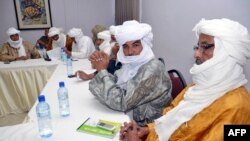Rebel groups from northern Mali have agreed to end hostilities and present a united front ahead of negotiations with the Malian government that begin in Algiers next week.
With peace talks between the rebels and the Bamako government around the corner, representatives from two rebel groupings have signed an agreement to end fighting and work towards a sustainable solution for northern Mali.
The agreement was signed Thursday in Burkina Faso’s capital Ouagadougou where the rebel groups - including the National Movement for the Liberation of Azawad, the MNLA; the High Council for the Unity of Azawad, the HCUA; and Arab Movement of Azawad, the MAA - have gathered before negotiations starts on 1 September in Algiers.
In recent months, clashes between the MNLA and the MAA have caused new displacements in the north.
Positive step
The agreement is a small but important step towards ending Mali’s 18-month long crisis. It started in 2012 with a Tuareg separatist rebellion and a military coup that fractured the country and led to Islamist extremists occupying Mali’s North. Ten months later the extremists were pushed out by international forces. Despite elections a year ago, violence continues in Mali’s north and talks are aimed at plotting a road map for reconciliation and unity.
David Gressly, with the U.N. Stabilization Mission in Mali, MINUSMA, says he thinks all parties realize they share a common interest in a comprehensive agreement.
“It is absolutely essential to have an agreement in the north of Mali if we want stability, a return of development, to remove the sense of isolation and marginalization that many in the North feel, even those who did not take arms in rebellion,” he said.
The first round of discussions were held in July in Algiers.
At that time representatives of six northern Mali armed groups, including the MNLA, the HCUA and also representatives from Songhay and Peuhl militias, met with a government delegation led by Mali Foreign Minister Abdoulaye Diop.
But the main challenge is reconciling the various agendas of the rebels factions says professor Issa N’Diaye at the University of Bamako.
He says international pressure - especially from France which still has troops in Mali - will be essential to get the groups to reach an agreement.
Questions remain
The main issue on the agenda is the status of northern Mali, roughly two thirds of the country’s territory.
While the separatist rebel groups have dropped claims for independence and opted for autonomy, it is still not clear what form it could take. The government has been very clear on how far it willing to go.
Prime Minister Moussa Mara says the goal is “a political and social solution that all parties can agree to within the limits drawn by the government.”
Those limits mean that Mali will remain one inseparable country - with a secular government and the continued presence of the Malian Army and police throughout the territory.
A definitive agreement would end 50 years of armed conflict sparked by decades of Tuareg separatist movements.








